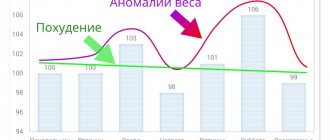We are talking about grandmothers, mothers and wives who prepared delicious borscht, baked pies, cut salads and fried chops. We invested love and care into this process, spent time and effort. But you can’t possibly eat that much. And we are forced to upset them by leaving some of the food on the plate. How do you feel when they look into your eyes and ask: “Didn’t you like it?” or “What, isn’t it tasty?”
Many of us really eat to please our loved ones. Let it be better for us to have extra pounds, shortness of breath, problems with the heart and blood vessels. Let our joints hurt, let it be hard for us to bend down to tie our shoelaces. It’s better that we don’t give a damn about our health, self-esteem and future than for our beloved grandmother (aunt, mother, sister, wife) to be upset! No no and one more time no! The self-esteem of our loved ones is much more important than ours. Don't care about yourself! The main thing is that loved ones are happy and continue to exist in their fictional world, where food is the only way to express love and care.
Under no circumstances will we tell our loved ones the truth that there are other ways to demonstrate love! Let them continue to remain in the dark! Let them think all their lives that food is a super value that needs to be worshiped. After all, both you and your loved ones deserve exactly this!
Or is it still not?
Of course, if you refuse extra food, your loved ones who prepared it may become upset and actually experience negative mental states. But they can simply pretend to manipulate you - this also happens. After all, when there is a fat person next to you, you begin to feel less fat and ugly. When you live with someone weak-willed, you can forgive yourself some weaknesses. I am not at all saying that your mother or grandmother is deliberately fattening you up in order to assert themselves at your expense. I'm just saying that it happens.
This does not mean that our loved ones wish us harm. Often they don’t even understand that they are unconsciously working out some false social programs.
Anorexia
Anorexia nervosa
is a deliberate eating disorder with the aim of losing weight, losing weight or gaining excess weight, which the patient himself causes and subsequently maintains. Anorexia nervosa is characterized by a pathological desire to lose weight and an intense fear of obesity; the patient has a distorted perception of his physical shape and is constantly worried about weight gain, even if this is not true. Anorexia is most often observed in girls and young women.
The main criteria for diagnosing anorexia in ICD-10 and DSM-5 are the same, but there are some differences: the absence of menstruation (amenorrhea), according to the DSM-5 criteria, is not a leading sign for diagnosis, but according to the ICD-10 classification, the absence of one or more leading signs such as amenorrhea or weight loss are highlighted for atypical anorexia nervosa.
All of the following are required to diagnose anorexia nervosa:
- Body weight is maintained at least 15% below predicted (a higher level is not achieved or decreases) or the Quetelet body mass index (the ratio of body weight in kg to the square of height in meters) reaches a reading of 17.5 or lower. Before reaching puberty, there may be an inability to gain weight during the growth stage.
- The patient himself causes weight loss: he stops eating food that can make him gain weight, as well as by doing one or more of the following actions: inducing vomiting, taking laxatives, excessively increasing physical activity, taking appetite suppressants or diuretics.
- Psychopathological distorted perception of the appearance of one’s body and figure, pathological fear of obesity, and this fear takes an obsessive form; The patient considers extremely low weight acceptable.
- Endocrine disorder of a general type along the hypothalamus-pituitary-gonad axis. In women there is amenorrhea, in men there is loss of potency and libido. There may also be increased levels of growth hormones and cortisol, changes in metabolism, disturbances in insulin secretion, and a lack of thyroid hormones.
- At the initial stage in prepubertal age, the manifestations of puberty slow down or do not appear at all (growth stops, girls do not develop mammary glands, the first menstruation does not occur, in boys the genitals remain juvenile).
Signs of anorexia also include:
patient's denial of the problem; sleep disorders; panic fear of gaining weight, fear of one’s reflection in the mirror, fear of eating; depression; causeless anger, resentment. Sometimes there is an increase in interest in everything related to food - recipes, articles on cooking and gastronomy, various diets, preparing various dishes only for others, without one’s participation in the process of eating food. The changes also apply to social life: refusal to participate in general events where meals are expected, up to the cessation of all communication; frequent visits to restrooms and long stays there.
Among physiological disorders, problems with regulation and their cycle are noted; cardiac arrhythmia (often leading to sudden cardiac death due to a lack of potassium, magnesium and other minerals); chronic weakness, fainting, dizziness, muscle spasms; constant feeling of cold due to slow heart rate. Hair loss, dry and pale skin, the appearance of small hairs on the face and back, and structural damage to the nails also occur. In the functioning of the digestive system, disorders and painful cramps in the stomach, chronic constipation, nausea, swelling of the abdominal cavity, difficult and painful digestion are observed. Consequences such as osteoporosis, frequent and painful fractures of vertebral bones are not uncommon; reduction in brain mass. Patients are mentally unstable: hyperactivity is replaced by apathy, manifestations of social phobia, panic disorders, anxiety, obsessive-compulsive disorder, and thoughts of suicide are frequent.
The course of the disease, its development and outcome can take various forms: recovery; relapses; death as a result of irreversible changes in internal organs (without treatment, the probability of death reaches 5–10%); development of uncontrolled overeating and progressive weight gain is possible.
Treatment of anorexia
Treatment for this type of eating disorder requires general physical improvement, rehabilitation, and weight restoration. Psychotherapy is of primary importance: behavioral, cognitive and family. Behavioral therapy promotes weight gain. Cognitive – corrects the perception of oneself as obese and overweight, helps overcome feelings of inferiority, and reduces dependence on the appearance of one’s own body. Family therapy is especially indicated for patients in childhood and adolescence.
Rehabilitation
provides support during the entire course of treatment, using physical exercises, correction of sleep patterns, therapeutic diets, informing the patient about the achievement of goals and tasks to be solved.
Bulimia
Bulimia nervosa
– an eating disorder, which is characterized by regular bouts of overeating against a background of obsessive control over body weight and the adoption of extraordinary measures to reduce the influence of the food eaten on weight gain. These measures include: cleansing the body using induced vomiting or enemas, taking diuretics and laxatives. Bulimia is common in certain diseases of the central nervous and endocrine systems.
Bulimia nervosa, both according to the DSM-III-R classification and the ICD-10 criteria, is included in the group of mental disorders. Clinical manifestations include symptoms such as: dehydration, low potassium levels, metabolic disorders, arrhythmia. With frequent vomiting, erosion of tooth enamel occurs.
When diagnosing, there are three main signs:
- Overeating, uncontrolled consumption of large quantities of food. Manifestation: attacks of sudden appetite and absorption of huge amounts of food; attacks of painful hunger and night hunger and/or night eating.
- Regular use of vomiting, taking diuretics and laxatives, strict diets, grueling physical activity as a way to influence body weight.
- The dependence of self-assessment on body shape and weight.
Treatment for bulimia
Bulimia nervosa is treatable and many disorders are reversible. Complex treatment is carried out by a psychotherapist, psychiatrist and nutritionist. First, you need somatic treatment aimed at restoring your physical condition.
The use of medications, in particular antidepressants, may be prescribed if there are clear signs of depression and/or anxiety or in the presence of concomitant mental disorders (neuroses or obsessive-compulsive disorder).
Among the various methods of psychotherapy for bulimia, cognitive behavioral therapy is especially indicated, the task of which is to bring the patient to an awareness of his responsibility and control over nutrition. Other types of therapy are also used: behavioral, interpersonal, family therapy. The final goal of any method of psychotherapy is the patient’s acceptance of himself, his appearance, his individual physical parameters and the transition to an emotionally healthy attitude towards life.
Psychogenic overeating
- This is compulsive overeating, which leads to excess weight and occurs as a consequence of distress. People who are prone to obesity are especially susceptible to overeating, and the presence of negative stressful situations (loss of loved ones, accident, etc.) is a trigger. Sometimes the disorder begins after childbirth or surgery.
With compulsive overeating, there is often no real physical feeling of hunger. This is why you choose foods rich in carbohydrates or fats (fast food, snacks, sweets). Such an attack-like snack distracts from stress, but not for long, and the person soon needs a new meal.
Psychogenic binge eating varies in severity from mild to extreme, bordering on bulimia. The following possible symptoms are identified:
- episodic loss of control over the process of food absorption;
- episodic overeating in stressful situations;
- eating an abnormally large amount of food in a short period of time;
- eating large quantities of food without feeling hungry;
- absorption of food until it is impossible to breathe and move;
- eating in a depressed state (dejection, sadness, boredom);
- eating alone out of a sense of shame associated with the very act of eating;
- eating alone in order to hide the fact of gluttony;
- feeling disgusted, guilty, or depressed after eating.
Compulsive overeating
is designated as a special diagnosis of “Eating and Eating Disorders” in both ICD-11 and DSM-5, and is characterized as the patient consuming an amount of food over a given period of time that is many times more than most people would eat in a similar period of time in a similar situation. It is also necessary to acknowledge the loss of control over both the amount of food and the cessation of the eating process. To be diagnosed with binge eating disorder, three or more of the following symptoms are required:
- Consuming food until you feel uncomfortably full.
- Eating occurs much faster than usual.
- Feeling disgusted with yourself, guilty, or sad after eating.
- Eating large amounts of food without feeling hungry.
- The habit of eating alone due to the shame of realizing how much has been eaten.
ICD-10 does not identify compulsive overeating as a separate mental disorder, but, nevertheless, determines that excessive obesity can lead to an individual’s lack of confidence in his appearance and contribute to depressive states. Obesity, as a side effect of the use of antipsychotics or antidepressants, is also not considered in the context of binge eating disorder, but is classified as drug-induced obesity. When diagnosing psychogenic overeating, it is necessary to exclude polyphagia (gluttony, constant need for food).
Compulsive overeating
is an eating disorder that combines physiological (excess weight and associated metabolic problems, etc.) and psychological (severe emotional experiences of the patient, difficulties with restrictions and diets) factors. Accordingly, treatment can only be effective with an integrated approach to therapy conducted by a psychotherapist/psychiatrist and a nutritionist. Antidepressants, antiepileptic drugs and drugs for the treatment of obesity are prescribed as medications.
Take a closer look at what you eat
One of the best ways to start eating less junk food is to learn more about what you're actually eating and how it's produced. The truth about the preservatives added to processed foods and the various additives used in snack foods may make you cringe and think twice before opening a brightly colored package next time.
Other eating disorders
Allotriophagy
– a specific disorder associated with eating inedible substances of a nonbiotic nature (sharp metal or glass objects, bolts, pins), in a mild form, occurs in pregnant women (chalk, cardboard) as a consequence of endointoxication. This disorder is common in adulthood and may occur due to unhealthy appetite.
Diabulimia
– Patients with insulin-dependent diabetes deliberately take an insufficient dose of insulin or stop taking it completely in order to lose weight.
Drankorexia
(“alcohol diet”) – meals are replaced by drinking alcohol with the intention of controlling body weight or losing weight.
Orthorexia nervosa
– obsessive eating only healthy foods.
Selective eating disorder
– refusal to eat a certain type of food, limiting the names of foods that can be eaten, refusal to try new foods, preferences in color, shape or type of food.
Pregorexia
– a specific eating disorder in pregnant women, manifested in a conscious refusal to eat in order to maintain a slim figure, the adoption of various tricks to hide a growing belly and not gain weight, and exhausting sports activities.
Among the possible causes of eating disorders, there are somatic (metabolic disorders, hormonal imbalance leading to impaired serotonin uptake, dysfunctional disorder of satiety mechanisms), affective (distress, depression), social (stereotypes and values in society), personal (parental influence , family situation, personality traits). In any case, each eating disorder requires an integrated approach to treatment and joint patient work of the patient and specialists - physiologists, nutritionists and psychotherapists.
How can we help?
| If you have discovered some of the described symptoms, this may indicate the development of a mental disorder. In this case, it is worth contacting a psychiatrist for diagnosis and initiation of timely treatment. In addition to face-to-face appointments , we offer a remote consultation service (online) , which is not inferior in quality to a personal meeting. Thus, you can receive qualified assistance from a high-level specialist, no matter where you are. |
Our clinic, near the Eastern Administrative District of Moscow, in Reutov, employs specialists who have extensive experience in treating mental disorders. We use the most modern and advanced techniques, guided by the principles of evidence-based medicine. Effective assistance and confidentiality of information constituting medical confidentiality are guaranteed.
Step away from your daily routine
Do you associate three o'clock in the afternoon with going to the nearest store where you buy a package of sweets or a chocolate bar? Try changing your route and instead of visiting the “junk food outlet,” just walk around the block.
A 2015 study of 48 people published in the scientific journal PLoS One found that a 15-minute walk temporarily reduced cravings for high-calorie sugary snacks. By the way, a short walk has many other benefits for your health.










